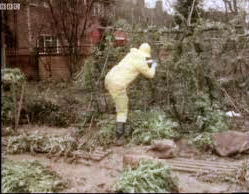
January and February are quieter months in the garden centre, and we get a little more time to tidy up, revamp displays, and think ahead to the jobs that might give us a march on the gardening year. Amongst other things, we are busy dividing perennials to give us new healthy plants, and you can do the same if you have any potted material that has outgrown its pot or, if the ground is not too cold and wet, you can still split up larger clumps in your beds. Given the rainfall in recent weeks, you might need to wait until we’ve had a few consecutive dry days before attempting that. Not only will you risk damaging and compacting your soil structure if you stand too much on wet soil, but there is always the potential shame of a Margot Leadbetter moment. Those of you old enough to remember the Good Life should know what we mean. Those not old enough, ask someone who is. Here is a hint.
One of the plants coming into its own at this time of year is the hellebore, and many are starting to appear in garden centres, or even flowering in our gardens, although, in truth, it feels a tad early for the latter – this mild weather again. There is little prettier than a swathe of hellebores in an edge of woodland area, perhaps with some clumps of snowdrops and native primroses dotted in between. Hellebores need a slightly damp, humus-rich soil, and thrive best in part shade. This is why they fare so well under deciduous trees which provide that shade, and the leaf fall to create the humus-rich soil.
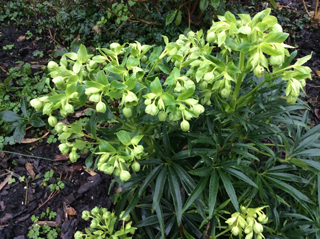
Hellebores are a relatively expensive, evergreen plant, but that it is because they take a long time to grow from seed. If they are in a good position, the orientalis type will bulk up reasonably quickly to a good clump. These will also cross hybridise if you have a number of different ones, creating some interesting new varieties. However, if you are lucky enough to have them seeding in your garden, it will be some 5 years between a seedling first appearing and that plant flowering, so be patient. Once you have a decent sized clump, you can divide them in spring after flowering.
Hellebores are not scented, with the exception of the (we think) rather unfairly named Helleborus foetidus – the Stinking Hellebore. Stinking is a term we generally reserve for our respective dogs, Rhubarb and Benson. At worst, H. foetidus has a slightly peculiar whiff, but only if you’re really up close, or use it as a cut flower. It has a striking display of handfuls of bright green, cup-shaped blooms and cuts quite a dash at this time of year. A real benefit of all hellebores, and especially the stinker, is that their blooms last for weeks and weeks, fading only slightly as they go to seed. So, they cost more than average, but they are a great gardening investment, and you will have them and their progeny for years and years to come. Go on, treat yourself and plant some. And if you are already a convert, don’t forget Bosvigo’s wonderful hellebore day in February – take your sharp elbows, quite a few pennies and be prepared to eat lots of cake.
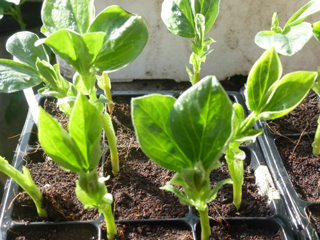
Last month, we hinted at some seeds you could start off now to make the most of a longer growing season. If you are a keen vegetable grower, now is the time to start off your chilli and capsicum pepper seeds. They need a very long season, so the earlier the better for a good crop. We have seen a number of suggestions for improving germination of pepper seeds, such as on damp paper towels, but the keys are a bit of heat and some moisture. Pepper seeds germinate best at 25C or more, and in a moist but not wet setting. Plant the seeds in a light compost, with only a fine sprinkling of compost to cover the seeds, and mist regularly with a plant sprayer.
If you have a heat mat, or a heated propagator, that is ideal. If not, a sunny window sill above a radiator should do the trick. Bear in mind they can take some weeks (up to 5 apparently) to sprout, so don’t lose heart if you don’t see results overnight. Once the seedlings are big enough to transplant, keep them indoors either in a greenhouse or cool conservatory and bring on until they form nice healthy plants – peppers won’t tolerate being outside in our climate until the height of summer, and even then, the nights may be too cool for them.
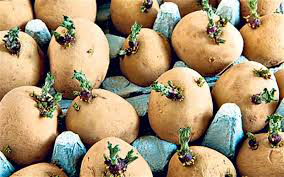
Peas and broad beans can be sown under cover now too, and by under cover, that could mean in seed trays in the greenhouse or cool conservatory, or in the ground if you have raised beds that have been covered against the worst of the cold and wet. Just bear in mind Mr Mouse, who delights in snaffling sprouting beans and peas. It is completely disheartening to see little sprouts one day, and an empty dent the following day. Protect your produce as you see fit.
Seed potatoes are also in the shops now, and it is time to chit! A technical term for something and nothing, really. Simply position your seed potato with the most advanced-looking eye upwards (egg boxes make great chitting vessels) and leave in a bright but cool place until the shoots develop more. You probably need 4-6 weeks for some good growth before planting. By the way, chitting isn’t absolutely essential, but it gives your spuds a head start. If you run late with buying your seed potatoes, you can plant without chitting, but they will take a bit longer to produce the crop.
A few hints on buying seed potatoes: most garden centres have a range on offer, but they are ready bagged. Try and find somewhere which stocks loose ones, and not only can you be selective about the variety, but you can mix and match for a more diverse crop. If you pick large potatoes, remember that, as long as each resulting segment has a good eye, you can cut the seed potato into 2 or 3. It could save you a few pennies if you are planting a lot.
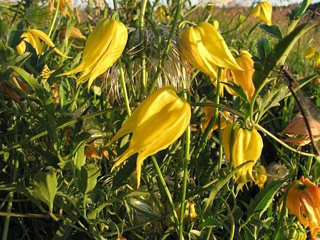
On the flower front, antirrhinums (thank goodness for spellcheck), stocks, sweet peas, and other hardy annuals benefit from an early start, so plant in free draining compost and place on a light window sill. They will probably take 2-3 weeks to sprout, but will give you a lovely early display once in the garden.
There is one other job which we are reminded of in February, with the impending appearance of Eros, and all things heart-shaped. (We prefer pancake day ourselves…..). We once heard a TV gardener whose name escapes us call the cutting back of the late flowering clematis as the St Valentine’s Day Massacre. It’s a good reminder of when to do that job, along with Chelsea Chop and Hampton Court Haircut. That is, provided we are not in a cold snap, in which case leave it a few days.
So, if you have any of the late summer or autumn flowering clematis such as C. tangutica or viticella varieties, or simply the larger flowered varieties which are labelled as late flowerers, then cut them back to a healthy pair of buds about 30cm from the ground. In the case of a tangutica, you are probably cutting an awful lot off, but do not worry, it will race away again when growth restarts in earnest.
Well, that’s probably enough to keep you out of mischief for the few weeks. By the time we come back in March, we might even have shed our thermals and lost our gills! Happy chitting!
Sarah Daniel and Helen Robins, Pengelly Garden Centre

